What is the best software to edit audio? Asking the question is like searching for a best cast iron pan for cooking. The quality of the pan matters, yet it is the person holding that pan that makes all the difference.
This post gathers standalone audio editing software for users at different skill levels, from simple program with merely cutting and splicing features, to wave editors with advanced features for restoration and fixing, as well as DAWs (Digital Audio Workstation) with multi-track editor and music production features.
Please note that the list is not in the order of importance, because each tool has a different market to entertain, and thus different feature sets. Comparing "audio editors with some DAW functions" with a "DAW with editing functions" isn't a level playing field. You can use multiple tools for different situations.
Best Audio Editing Software for Beginners - VideoProc Vlogger
Supported OS: Windows, Mac (M1 chip supported natively).
Price: Completely free, no restriction.
Pros:
- Edit audio without steep learning curve.
- Cut, trim, split, merge, mix audio easily with straightforward UI.
- Use 10-band equalizer for custom settings or use EQ presets.
- Reduce audio noise, extract audio from video, detect silence/onset/beats, etc.
- Change frequency, apply voice changer, create audio panning and other FX.
Cons:
- No audio compressor to compress the dynamic range of the sound.
- No MIDI support or tools intended for serious music production.
For beginners who have audio editing related tasks at hand, VideoProc Vlogger is the most suitable editing software to get going. You don't have to spend days learning how to use the software and get familiar with complex panels and parameters.
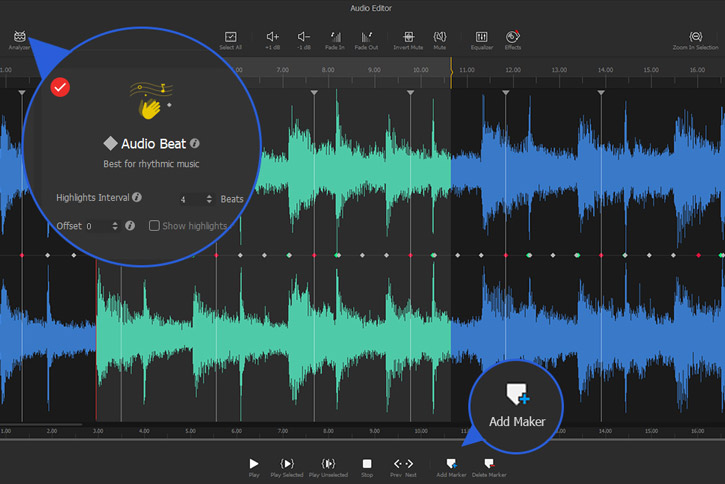
If you want to enhance the quality of the audio, you can use the built-in noise reduction feature, and the program will intelligently analyze your audio and fix it automatically. You can fine-tune a few of the parameters to get a better result.
If you want to mix several audio tracks, add fade-in and fade-out effects, adjust the overall volume, split or trim the clips, apply EQs, add reverb, echo, or other effects, you can easily achieve that since the UI is easy to navigate with.
Best Audio Editing Software for Professionals
1. Audacity
Supported OS: Windows, Mac, Linux
Price: Free
Pros:
- Open source and free with decent functions of editing, recording and applying effects.
- Lightweight for low-specs computer.
- Support VST plug-ins and MIDI files.
Cons:
- The UI is less enjoyable comparing to other tools in this list.
- Less stable for complex multi-track projects, might lead to file corruption occasionally.
- Require downloading codecs to export files in certain format.
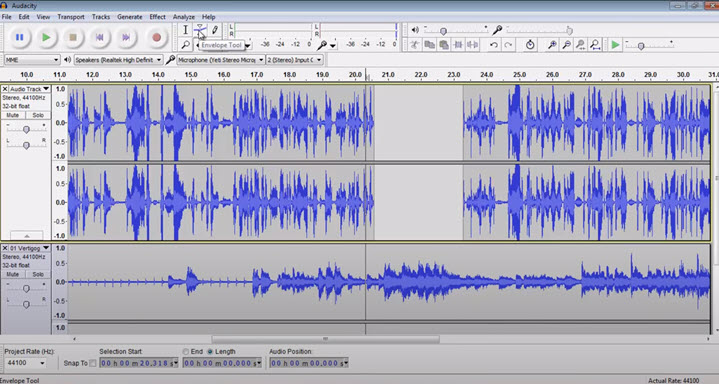
Audacity is standalone audio editing software with recording, remixing and VST features. This lightweight tool uses few computational resources, and is quite robust with it functionality. It is possibly the most popular cross-platform audio editor among beginners and hobbyist, because it is completely free and works equally well as other premium programs.
Basic edits such as cutting, trimming and splitting audio are easy to handle. You can make recordings for podcasts, video games and audible books, remove noise, and assemble audio clips easily in Audacity. For advanced users, Audacity also supports large amount of plug-ins for new effects.
For recording, Audacity supports up to 192,000Hz sample rate, and at 24-bit depth. You can record multiple channels at once, with level meters that monitor the volume and prevent audio clipping [1] and other problems. Professional recordings sound great not only because of microphone and other equipment, but also thanks to editing techniques. Audacity has a decent compressor built-in to dynamically adjust the volume of your recordings according to the threshold, compress ratio and other settings.

For noise reduction, Audacity offers you a handy wizard to remove sibilance, rumbles, plosives and background noises, or remove vocals from a song for karaoke. You only need to record a few seconds of "Silence" on the audio track, and let Audacity to analyze this sample. You can tinker with the settings to clear up the noise from your environment, or simple go ahead with the default settings.
Audacity has an impressive library of effects, such as fade in and out, auto duck, and amplifier. You can also use the envelope tool to create audio panning effects, which gives the listener an illusion of 3D space where sound moves back and forth between the left and right side of your headset.
This program also supports VST plug-ins, making it as versatile as some of its paid counterparts. That being said, its main gig remains editing and recording, and may fall short on industry-level music production. For instance, even though Audacity optimized the compressor with threshold and attack settings back in 2009, it still lacks the real-time preview when the compressor [2] starts working.
Please note that default effects in Audacity are destructive: once you save and close the file, there is no way to go back to the original version. If you record and edit your audio file in Audacity, make sure to create a backup file, i.e. simply duplicate it to another track.
To wrap up, Audacity is the Go-to free audio editing software for beginners and hobbyists. There are abundant free tutorials and forums for you to get the rope of audio editing, without spending a dime. Once you get familiar with those sliders and parameters, knowing what decisions to make and how to make adjustments accordingly, you will find Audacity limits your creative power. At that time, you could go a step further and move to advanced DAWs.
2. Adobe Audition
Supported OS: Windows, Mac
Price: $20.99/month for the single app | $52.99/month for Creative Cloud
Pros:
- Powerful audio repairing and fixing functions with precise control.
- Deep integration with other Adobe programs such as Premiere Pro.
- Handy features for podcast production such as auto-ducking music when the soundtracks are triggered.
Cons:
- Subscription-based license is pricey if you are working on your own.
- No music creation tools and the MIDI support is less desirable.
- Not for casual users and beginners.
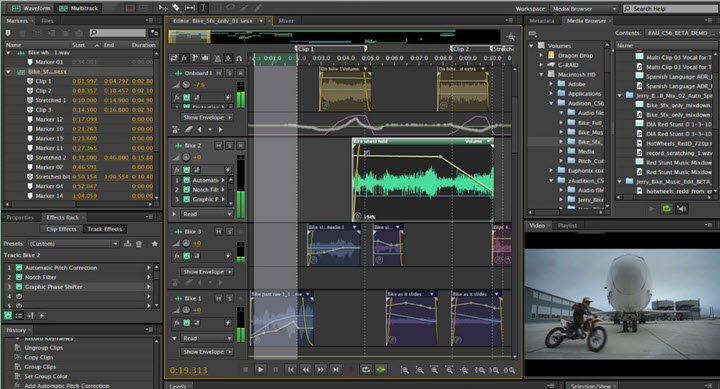
Adobe Audition is a powerful audio editor for audio restoration, video post production and podcast recording and editing. It does everything Audacity does, and offers more comprehensive features in terms of audio editing. Yet it lacks music composition tools comparing to a professional digital audio workstation (DAW). If Audacity is on the side for free audio editing, and DAWs on the other side for professional music production, then Adobe Audition sits in between in a category of its own.
Audition is the rebranded version of the much-loved Cool Edit by Syntrillium Software, which was acquired by Adobe in 2003. It naturally inherent the dual design of waveform editor and multi-track editor, allowing you to make precise and granular control over the audio and mix multiple soundtracks. Using the waveform editor, you can easily cut and trim individual soundtrack, correct and repair problematic audios [3], apply sound effects, add reverbs and change pitch manually. The multi-track editor in Audition does a nice job for remixing. There are powerful EQ controls for each channel, envelopes for automating mixes, and loop tools.
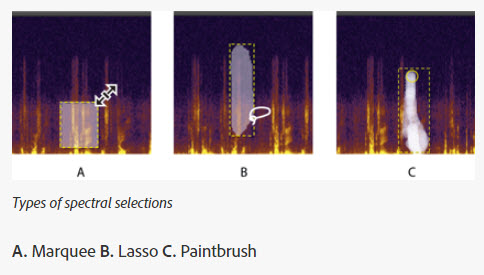
Multi-track recording is the feature that wins favor with many podcasters and content creators. In Audition, you can record on multiple tracks with several microphones, and that gives you a lot of control and flexibility. Let's say you are hosting a roundtable-style discussion show, you can assign separate EQ (Equalization) [4] for each track and record individual speakers directly into the multi-track.
For videographers, the vast library of sound effects and VST extensions bring more possibilities to spice up your soundtrack of a video. You can add telephone filter effects, underwater sound, or add reverbs to simulate the sound in a certain environment. The best thing is, effects applied to the multi-track editor are non-destructive. You can freely play around with an effect and undo it at any time.
Audition has a text-to-speech generator built-in. You can paste text and let Audition create a realistic voice-over from that content. The tool taps on the audio libraries on your system to create the synthesized voices, and thus there is a difference in the resulting audio on Windows and Mac.
In a word, Adobe Audition is the powerhouse for audio editing and repairing, and it does an excellent job with audio recording. The subscription-based license is privacy, but that doesn't prevent Audition from being one of the best audio editing software on this list. This program is nice to use in the workflow of video post production, with the handy dynamic link to switch to and from Adobe Premiere. However, it's less likely that a music studio would base its whole workflow around Audition. It is not designed with music production in mind.
3. Ocenaudio
Supported OS: Windows, Mac, Linux
Price: Free
Pros:
- Freeware with features enough for basic audio editing.
- Real-time previewing of effects and adjustments.
- Customizable hotkeys to speed up your audio editing workflow.
Cons:
- No multi-track handling and envelope tool.
- Lack of instructions or user guide from the official site.
- Does not support CD burning or ripping tools.
Ocenaudio is the best audio editing software for beginners. It is the brainchild of a Brazilian research group at LINSE. This tool is developed for tasks such as audio editing, spectral analysis and audio signal generation. If you are looking for a free audio editor that are intuitive and easy to use, Ocenaudio ranks high on the list.

This program is lightweight and responsive. It loads and quits very quickly, and it is also able to handle large files. For beginners, there is no sight of daunting sliders and parameters to scare you away, no matter you are here to trim and merge audios, or make a spectral analysis for phonetic studies. For advanced users, Ocenaudio excels at quick audio editing and processing work, especially when you are not in the mood to open a full DAW for a simple task.
An instance of quick editing is the multi-selection feature. In this program, you can select multiple silent parts indicated by the wave, and hit Delete to quickly cut them all at once. This is a time saver if you are editing podcasts or interviews that have many pauses and silent sections.
The best part about Ocenaudio is the ability to apply effects and filters with real-time preview. Thanks to that, you can make timely adjustments and listen to the outcome simultaneously. Here is another smart move: it automatically creates a backup of your audio file, so that you don't need to worry about destructive editing.
Other handy features include iPhone ringtone support, VST plug-ins, insert digital noise, edit MP3 metadata, etc. In short, you can use it as a simplified alternative to Cool Edit.
4. Wavosaur
Supported OS: Windows
Price: Free
Pros:
- Free and lightweight.
- Real time preview and ASIO support.
Cons:
- No Mac version currently.
- The interface is archaic, and the interaction is less intuitive if you are from the Cool Edit world.
- You might need to download and install additional codec when exporting mp3 files.
Wavosaur is a portable audio editor with the mere size of 1MB, lightweight enough that you can put it in a memory stick and edit audio on the go. Despite an interface that makes Wavosaur a dinosaur (pun intended) among other choices, this program is still a fully featured audio editor that supports VST plugins, ASIO driver and multichannel files. You can find the VST plug-ins on their site, ranging from VST compressor, limiter and equalizer to reverb, autotune, and chorus tools.
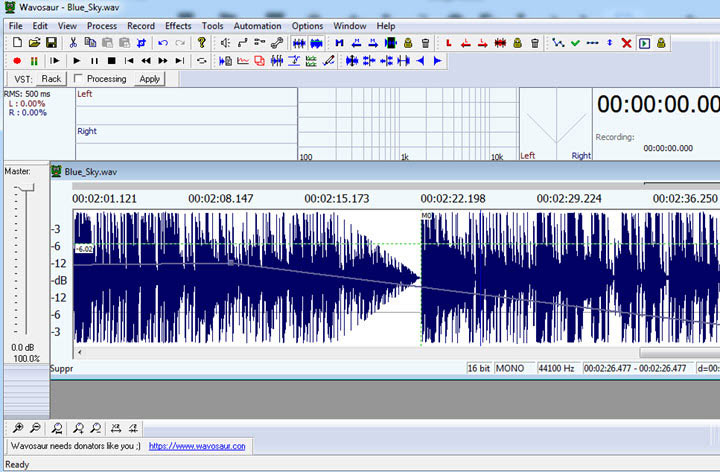
If you are not familiar with all those acoustic theories to navigate around VST, you can simply use Wavosaur as a basic MP3 converter and editor. You can convert audio file format, crop out unwanted parts, normalize audio, or use the envelope tool to manipulate volume. Same as Ocenaudio, Wavosaur also supports real-time effect processing. You can hear the difference instantly.
5. WavePad
Supported OS: Windows, Mac, iOS, Android
Price: $24.9 Standard Version | $34.9 Master Version
Pros:
- Wide choice of cleanup tools to enhance your audio recordings.
- Ready-to-use iPhone ringtone templates.
- Support CD input and burning.
Cons:
- Only works with a single audio track (though you can batch process multiple single tracks), no multi-track editor.
- Could be inefficient if you have huge piles of audio pieces to work with.
As the name suggests, WavePad is an audio waveform editor for single track editing. It can be a good companion for voice recordings and editing. You can cut out sections from the recordings, insert another audio piece into the existing work, or splice several audio clips into one entire track.
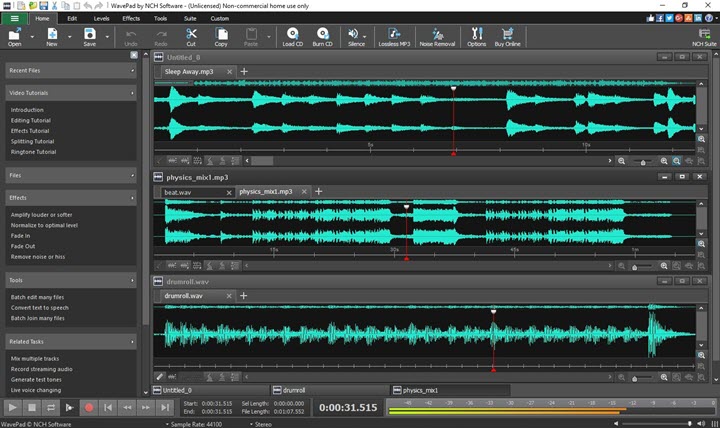
There are a handful of cleanup tools and filters to manipulate your audios. You can use the noise removal tool, compressor, amplifier, and high pass & low pass filters to achieve the desired result. However, if you have a trained ear and want to take the audio editing to the next level, you won't be able to find more advanced tools that other professional music editing software provide. For instance, the program doesn't include low shelf & high shelf pass or bell filters.
Besides audio recording and editing, there are handy tools for spectral analysis, text to speech synthesis and voice changing. You can also batch export and convert audio files to WAV, MP3, OGG, M4R, AAC, FLAC and several more.
6. GoldWave
Supported OS: Windows, Mac, Linux, iOS, Android
Price: $45 one time purchase | $15 per year
Pros:
- Detailed guide and active forum to solve your problems.
- Affordable program with decent features.
Cons:
- No multi-track editor or optical media burning capability.
- The program might slow down if you are working with large files.
Initially released in 1993, GoldWave is a dated but robust audio editing software. It is created for various tasks from the simplest recording and editing to more sophisticated audio restoration and enhancement. Despite its obsolete GUI design, this veteran program offers wide possibilities for small groups and home use.
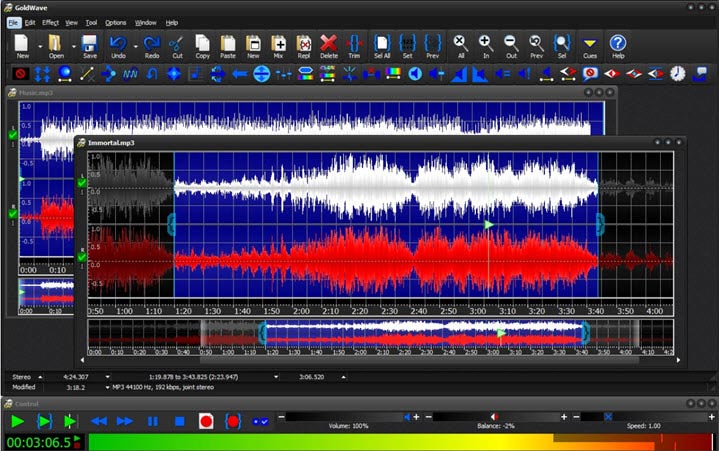
The program offers a handy feature for voice recording, where you can let it to start recording when there are voices. In that way, there won't be long pauses and silent part. The feature can be found in the level-activated function, with settings for decibel level that determines when to record. Another nice feature is the ability to remaster the old vinyl records and tapes. Once the audio is recorded, you can use GoldWave to enhance and restore it. There are noise reduction and filters that clean the click and pop vinyl recordings.
For audio editing and enhancement, you can use equalizer and compressor with visual display. It also offers you a wide selection of FX, including pitch, flanger and mechanize effect. You can add reverberation, time warp, and fade in and out effects to spice up your audio files. With precise controls, filters and analyzers, it allows you to meet the demand if you are submitting audio files with strict requirements.
7. Acon Digital Acoustica
Supported OS: Windows, Mac
Price: $59.9 Standard Version | $199.9 Premium Version
Pros:
- Ability to batch apply effect chain to multiple audio clips makes it a big time saver.
- Powerful time stretcher tool to change the tempo.
Cons:
- Takes time and effort to dig through if you want to fully grasp the functions.
- Not for casual users and novices.
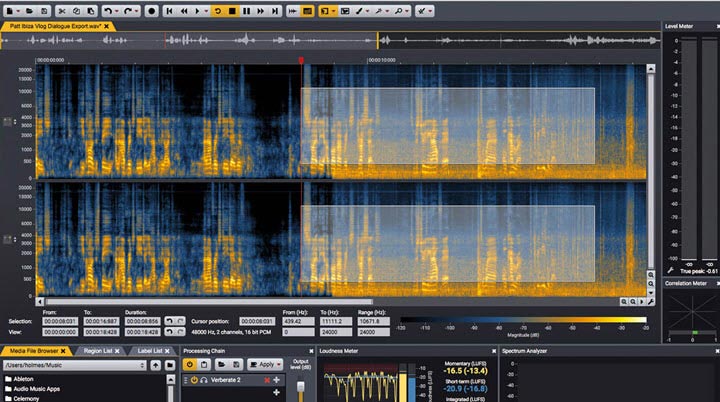
Acoustica is an advanced audio engineering program with editing, mastering and restoration capabilities. The clucky interface could be overwhelming until you learn its idiosyncrasies, and the dashboard is certainly not designed for novices trying to accomplish basic editings. With Acoustica, you can switch between waveform and spectrogram [5] for clip editing, cut, copy, insert and trim waveforms, use retouch tool to attenuate noise, add loops and fade. All your edits are non-destructive thanks to the program's high-quality editing engine.
For audio restoration, you can easily apply DeClick, DeClip, DeNoise, DeHum and more to clean up your clips and remove noise. Acoustic offers a wide variety of effects, from reverb to convolution reverb, flanger to phaser, and pitch change controls. With the right amount of adjustment, you can maintain the integrity and crispness of the audio file.
Note: Acoustica reviewed in the list is developed by Acon Digital, an Olso-based software producer. Please do not mistake it for Mixcraft 9 from Acoustica inc.
8. DVDVideoSoft Free Audio Editor
Supported OS: Windows
Price: Free
Pros:
- Free and lightweight.
- Option to change album art.
Cons:
- Cannot split stereo tracks to edit individually.
- Cannot preview the trimmed audio unless you export it.
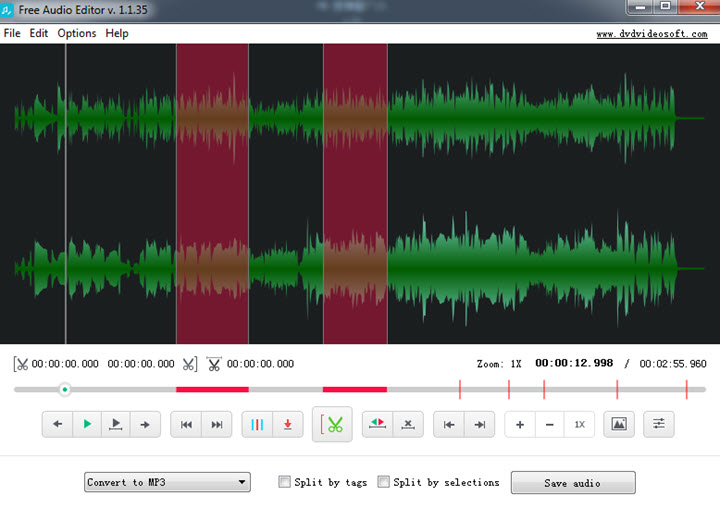
Free Audio Editor by DVDVideoSoft is a barebone wave editor designed for quick cutting. It mainly helps you to split audio or delete unwanted sections. You can also set album art and edit audio metadata. The only filters or sound effects you can use is the volume control, which allows you to boost the volume up to 10x and then rebuild the audio waveform. There are several output formats to choose from, including AAC, ALAC, AMR, FLAC, M4B (iPhone audiobook), M4R (iPhone ringtone format), MP3, OGG and WAV.
9. Free Audio Editor from FAE Media
Supported OS: Windows, macOS
Price: Free
Pros:
- Easy to understand interface.
- Option to produce 24-bit or 32-bit audio files with up to 192kHz sample rate.
Cons:
- No audio restoration tools.
- Not suitable for multi-track audio mixing.
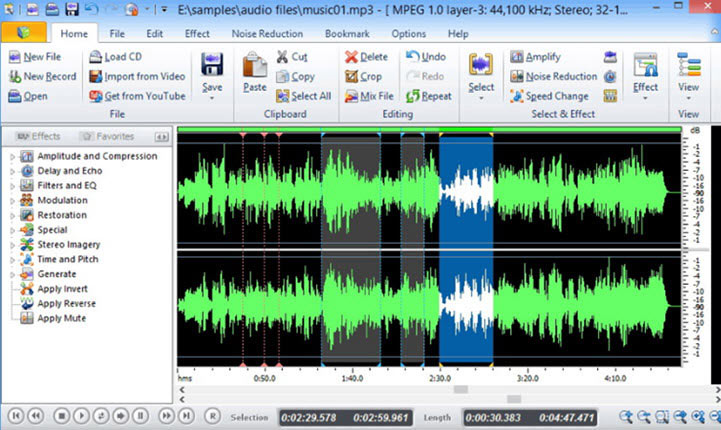
Free Audio Editor by FAE media is a lightweight wave editor for general users. If you still remember the good old Windows Movie Maker, you shall find this tool shares a similar design. All the basic tools you need are displayed under the menu bar. For editing, you can cut, delete, repeat or mix audio files, mute part of the section, or insert another file. For the effects, the normalizing tool and compressor are ready to use. You can add chorus, play around with flanger and reverb feature, or change the pitch and speed of the audio. It also allows you to grab audio from YouTube, CDs or video files.
10. Reaper
Supported OS: Windows, macOS
Price: Free Trial
Pros:
- It is stable, and you can record long audios, even in multi-track.
- Good integration with ASIO so that you can go live with streaming software such as OBS.
- Nice customization that will faster your workflow.
Cons:
- It is daunting for beginners and requires a steep learning curve.
- No 1-click restoration tool for the novices.
- Lacks a MIDI editing ability and there is no MIDI sample library.
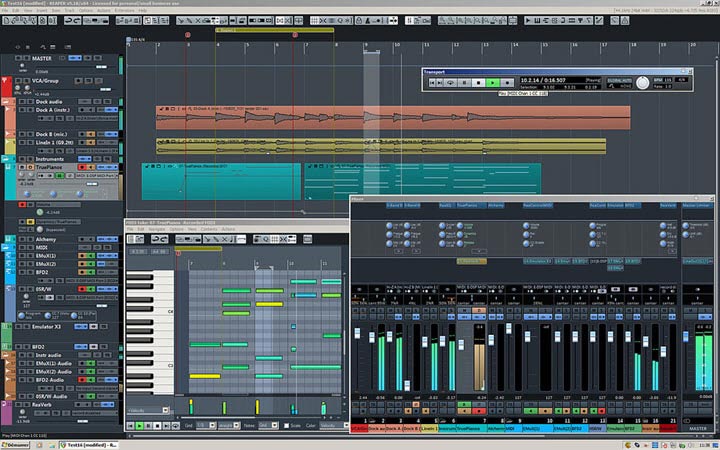
Reaper is a robust free audio editing program for music creation and audio analysis. Stable, fast, and light on CPU are the re-occurring tags people in the industry assign to Reaper. It offers you a whole month to try the full features and see if it is engineered to your taste. The best part about Reaper is its open-ended nature. It supports endless extensions so that people with different needs can create custom tools that interact with the program. For instance, ReaPack, a package manager for Reaper, is one of the most popular extensions.
Reaper is a trust-worthy tool to quickly turn your ideas into musical creation, especially when you have the light-bulb moment. No matter you are editing the sound of a feature film, doing phonetics search and other scientific sound measurements, or creating multichannel and ambisonics, Reaper won't let you down.
11. MAGIX Sound Forge
Supported OS: Windows, macOS
Price: Free Trial
Pros:
- Make edits rapidly with the help of hotkeys and markers.
- Support large amount of VST plug-ins and in a well-organized manner.
- Useful for spoken audio due to the ease of editing features.
Cons:
- The ability to listen to VST effects in real-time is less desirable.
- You cannot chain VST effects, instead, you need to undo a certain effect.
- It is less flexible if you want to apply FX while keep recording the dry signal.
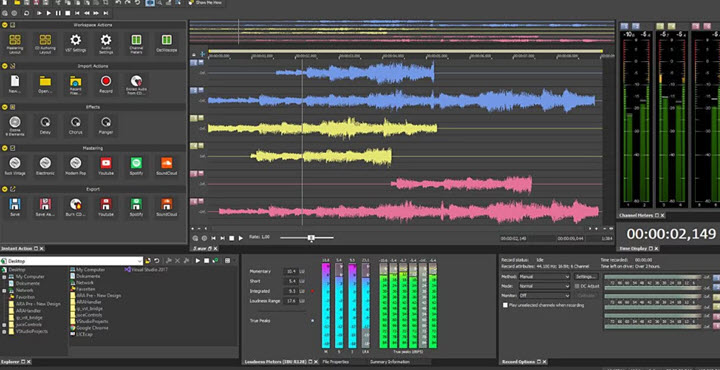
Sound Forge is a professional audio editing software for mastering, sound design and recording. It has been around for more than two decades, formerly developed by Sonic Foundry, then sold to Sony, and now owned by Magic Software GmbH. There are handy tools in SoundForge to create delay and reverb effects, including coreFX chorus, coreFX flanger, and coreFX delay. No matter you want the sound to be fuller, cooler, or dynamic, you will always find the desired FX to tweak with.
Sound Forge boasts of advanced recording tools to deliver high-quality audio. You can capture up to 32 audio channels in a customizable workflow that best suits you. It also supports threshold-triggered recording, so that you don't have to stay in the recording room to control everything. It also supports digitizing vinyl recordings into the working project.
The revamped graphical user interface is fully customizable, and the markers and hotkeys in Sound Forge can effectively improve your workflow. If you need to deal with numeral pieces of audio files, such as podcasts, interviews, and voiceovers, this tool can help you to make hundreds of edits without messing up.
12. AVS Audio Editor
Supported OS: Windows
Price: Free Trial
Pros:
- You can directly publish the finished audio to YouTube and other social media.
- Ready to use effects such as vibrato, chorus, flanger, pitch shift, and echo.
- Support mainstream audio and video formats.
Cons:
- Only works on Windows, and the license is bound to one PC.
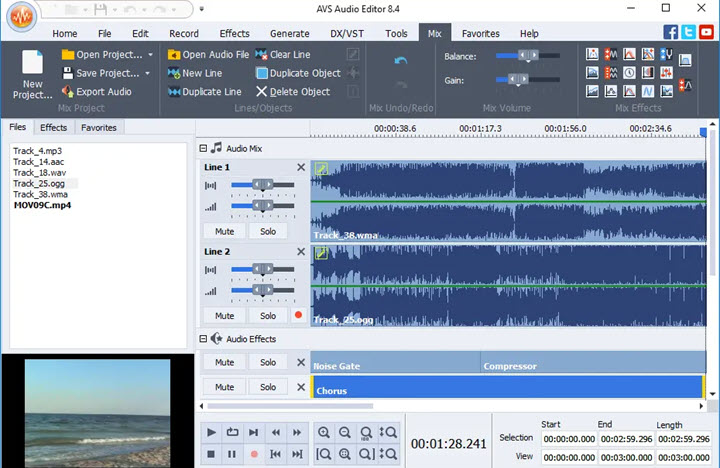
AVS Audio Editor is beginner-friendly audio editing software. It supports all the basic edits you can perform to sound waves, such as cut, trim, or glue together multiple soundtracks. You can add audio files into the editing area, or extract audio directly using this tool, including ripping from CD, or separate soundtracks from movies. General functions such as audio fade in and out, adjusting the volume using the amplifier, or remove noises from the sample are readily accessible from the menu.
There are plenty of effects and settings to use, and you can also add external tools and effects using the VST/DX tab. For advanced users, you can use the equalizer to enhance the audio according to your own taste, and use the envelope tool to adjust the volume dynamically. A bonus feature is its ability to creating ringtones for an iPhone. You can record or import a piece of audio, trim it to the desired length, and then save it to the M4R format.
13. Apple GarageBand
Supported OS: macOS, iPhone and iPad
Price: Free
Pros:
- Free yet powerful to record, mix and edit music.
- Intuitive interface for beginners to start mixing and recording.
Cons:
- It is tricky to export the audio file if you are using an iPad. You can follow this guide to save Garageband as MP3.
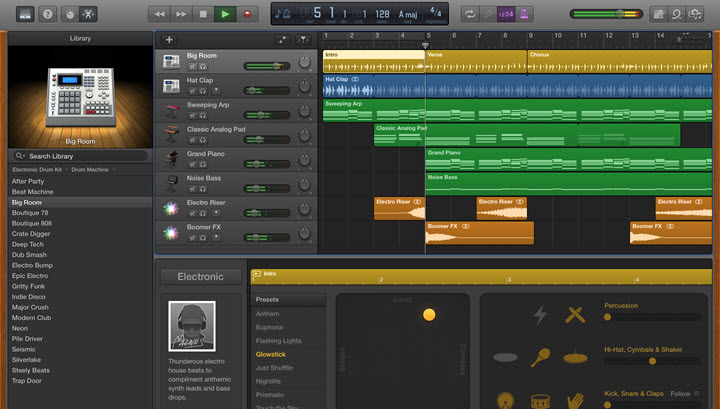
GarageBand is a perfect free audio editing and production app, available on Mac, iPhone, and iPad. If you like the design of Logic Pro X, you will probably enjoy this free alternative. It supports recording an electronic guitar, bass, and other instruments. With microphones, you can also record vocals. To better tap on the features, you can use a USB-compatible MIDI keyboard and audio interface such as PreSonus for the setup.
Though GarageBand doesn't offer you everything a professional-level music software has, it still offers nice features such as creating a mixing, adding reverb effects, or panning tracks to create stereo sound. After recording the instruments and vocals, you can freely copy, paste, and arrange your creations.
14. HYA-WAVE Online Audio Editor
Supported OS: Online Tool
Price: Free
Pros:
- User-friendly interface for beginners.
- Deliver nice work with simple edits.
Cons:
- Doesn't support multi-track editing.
- Cannot load large audio files.
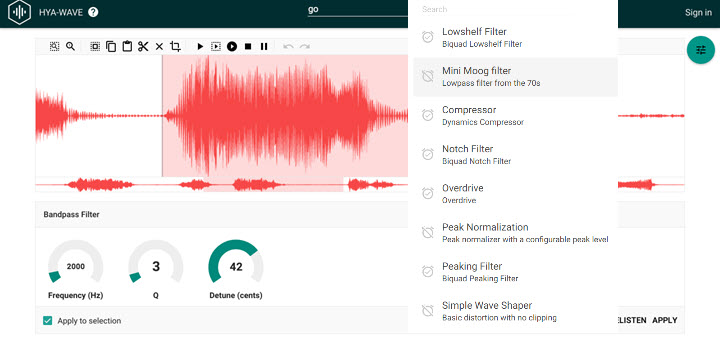
HYA-WAVE is one of the web-based wave editors that I turn to for quick editing. There are times when you don't want to launch up a full-blown desktop audio editor, and that's where HYA-WAVE comes to your aid.
The interface is simple and easy to understand, and there is no steep learning curve for the novices. It is straightforward to copy, paste, trim or clear the audio waveform, as easy and stable as doing the edits on desktop-based applications.
You can also add live audio effects, and shuffle among numerous pre-sets to find a desirable one. HYA-WAVE has all those effects that you would find in an offline wave editor, such as the highpass filter, high-shelf filter, compressor, peak normalization, etc. Sharing your work is only a URL away. You can save the audio in the cloud, and publish it to Facebook and Twitter.
15. Soundation Multitrack Online Editor
Supported OS: Online Tool
Price: Free
Pros:
- Free and web-based tool; ideal for students, beginners, and hobbyists.
- Decent amount of effects and instruments to use, including some interesting synths and MIDI packs.
Cons:
- Cannot save projects automatically. You can lose your hard work when there is a glitch.
- The interface is not fully scalable so that some sections might be too small for aging eyes.
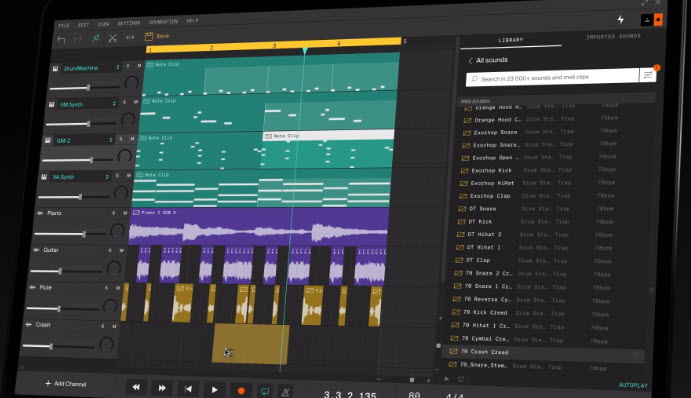
Soundation is an online editor to record, edit, and mix audio. Being free and easy to use, this tool finds its popularity among students in music classes. It only takes 5-15 minutes to set up, and once you get the hang of it, there will be so much fun to create your own music projects. Soundation makes it easy to collaborate. You can create groups, and members in the group can listen to each other's work and leave comments.
The workflow is basically the same if you are familiar with Ableton Live or Cubase. You can instantly start to record audio, use virtual instruments to create beat and melodies, and apply effects such as distortion, EQ, delay, flanger, etc. Soundation also offers a dazzling array of presets and loops, which can inspire you to create melodies even if you are a beginner.
The timestretch feature is quite handy for the users. You can import pre-recorded audio into Soundation, and it will timestretch the loops to match the tempo of your song.
Audio Editing Basics
1. What is clipping in audio editing?
Audio clipping occurs when the intensity (interpreted as volume) falls outside the maximum or minimum limits. It could be audibly distorting to the degree that the listener can instantly hear the effects. Represented by audio meter, audio clipping occurs when the audio hit or exceed 0dB. In waveforms, clipping is the area where waves get clipping off, resulting in a flat plateau shape.

Reducing the signal level can help you to avoid clipping. For instance, you can resort to volume envelope manipulation, or apply a compressor/limiter.
2. Compressor: What is it and why it matters?
In audio editors and music production programs, a compressor helps to change the dynamic range (i.e. difference between the loudest and quietest parts) of a signal. To put it in plain language, it can boost or reduce the intensity of the audio. In that way, you can better level out, colour and manipulate the audio.
The compressor will not be working the entire time, it starts to react when the signal reaches the dB level you set (threshold). It doesn't start immediately, as there is an amount of time (attack) designated for it to react; and it doesn't stop immediately, as you can set how quickly or gradually the effect will disappear or linger (release).
3. What are you dealing with in audio repairing?
Background noises and undesirable sound from the equipment, low-frequency rumbling, hum from electrical interference, and s-sounds created by sibilance when you speak… these are examples of noises that can be picked up in recording. Audition possesses an arsenal of tools to clean and repair audio for better sound quality. The recent version also added a plugin to remove unwanted reverberation from the sound file.

You can use diagnostics panel and spectral frequency display to make decisions, and reach out for flexible restoration tools. Audition allows the finest control you could ever imagine. For instance, when applying noise reducing effects, you can adjust the opacity of the selected area to determine how intense the effects will be – a genius analogous and visualized way to handle sound as if you are dealing with colors.
4. What does an equalizer do in audio editing?
The equalizer in audio editing software can boost or reduce a specific range of frequencies to alter the sound quality. There are four basic concepts in equalizer: type, slope, Q and gain. They affect and control different aspects when boosting or reducing the frequencies.
The type determines how you would like to affect the frequency. For instance, High-pass allows higher frequencies to pass and only affect lower frequencies (hence the alternate name Low-cut), and Low-pass does the opposite. Bell affects a specific point and its neighboring frequencies, creating a bell-shaped image. Shelf affects frequencies above or below an anchor frequency, and its image appears like a bookshelf, thus the name.
Gain determines how much gain or attenuate you want to reply, and it is measured by dB. Q factor can be simply understood as the range of influence to impose on a certain range of the spectrum.
5. Waveform vs Spectrogram
Waveform displays the changes of a signal's amplitude changes over time. It is the ebbs and flows that you see in many editors, where the wider vertical lines indicating louder sound, and narrow vertical lines represent the opposite.
The spectrogram indicates amplitude at specific frequencies as it varies with time. With such a visual representation, it is handy to adjust or remove the amplitude of specific frequencies.








